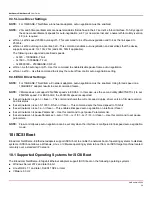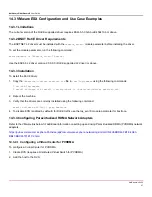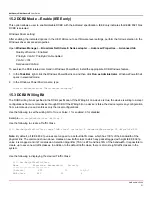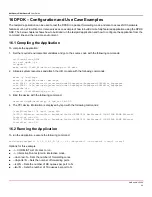
NetXtreme-UG100
42
NetXtreme-C/NetXtreme-E
User Guide
4. Set the NIC Partition Configuration parameters (see
Table 24 on page 42
).
13.4 Notes on Reducing NIC Memory Consumption
Because of the faster link speeds supported in this NIC, the default number of receive buffers is larger. More packets can
arrive within a given time interval when the link speed is higher, and if the host system is delayed in processing the receive
interrupts, the NIC must drop packets if all available receive buffers are in use.
The default value of receive buffers was selected to work well for typical configurations. If you have many NICs in a system,
have enabled NPAR on multiple NICs, or if you have only a small amount of RAM, you may see a Code 12 yellow bang in
the Device Manager for some of the NICs. Code 12 means that the driver failed to load because there were not enough
resources. In this case, the resource is a specific type of kernel memory called Non-Paged Pool (NPP) memory.
If you are getting a Code 12, or for other reasons wish to reduce the amount of NPP memory consumed by the NIC:
Reduce the number of RSS queues from the default of 8 to 4 or 2. Each RSS queue has its own set of receive buffers
allocated, so reducing the number of RSS queues reduces the allocated NPP memory. There can be performance
implications from reducing the number of RSS queues, as fewer cores participate in processing receive packets from
that NIC. Per processor CPU utilization should be monitored to ensure that there are no “hot” processors after this
change.
Reduce memory allocation by reducing the number of receive buffers allocated. The default value of 0 means the driver
should automatically determine the number of receive buffers. For typical configurations, a setting of 0 (=auto) maps to
XXXX receive buffers per queue. You can choose a smaller value such as 1500, 1000, or 500. (The value needs to be
in multiples of 500 between the range of 500 and 15000.) As mentioned above, a smaller number of receive buffers
increases the risk of packet drop and a corresponding impact to packet retransmissions and decreased throughput.
Table 24: NPAR Parameters
Parameter
Description
Valid Options
BW Reservation
Percentage of total available bandwidth that should be reserved for this partition. 0
indicates equal division of bandwidth between all partitions.
Value 0-100
BW Limit
Maximum percentage of available bandwidth this partition is allowed.
Value 0-100
BW Reservation Valid
Functions as an on/off switch for the BW Reservation setting.
True/False
BW Limit Valid
Functions as an on/off switch for the BW Limit setting.
True/False
Support RDMA
Functions as an on/off switch for RDMA support on this partition.
NOTE:
Only two partitions per physical port can support RDMA. For a dual-port
device, up to 4 NPAR partitions can support RDMA.
Enabled/Disabled
MAC Address
MAC Address for this partition.
–
















































